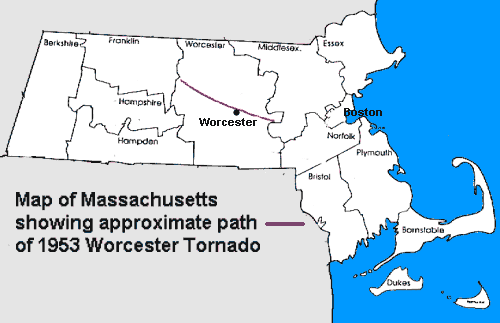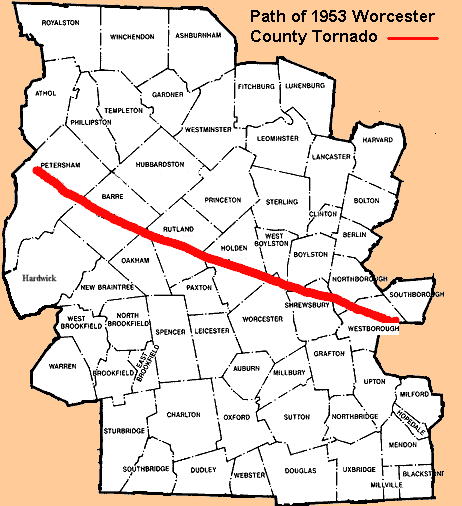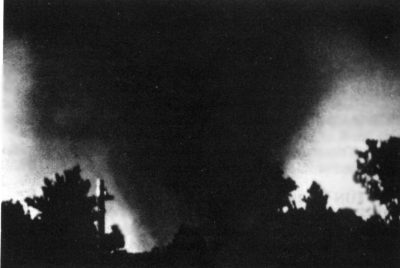 |
 |
| Home | Welcome | What's New | Site Map | Glossary | Weather Doctor Amazon Store | Book Store | Accolades | Email Us |
 | |||||||||||||||||||||
Weather Almanac for June 2003THE WORCESTER TORNADO OF 1953A few years back, I wrote about the connection between an Atlantic hurricane and William Shakespeare and the British Colonies of Bermuda. In this Almanac, I will look at a Massachusetts tornado and the influence it had on three men who would further our understanding of tornadoes and severe storms. The tornado to which I refer is the Worcester, Massachusetts tornado half a century ago on June 9, 1953. The three men are Howard Bluestein, Thomas Grazulis and Edwin Kessler.
Massachusetts TornadoesPerhaps the first tornado ever to be chronicled in North America struck the Massachusetts Colony on July 5 (or July 15 using our present calendar), 1643. John Winthrop, the Governor of Massachusetts, recorded in his journal that a "sudden gust" struck the colony. Travelling along a line from Lynn to Hampton, about 35 miles (58 km), the tempest lasted about a half hour, blowing "down multitudes of trees" and "lifted up their meeting house at Newbury [Massachusetts], the people being in it." One Native American was killed by a falling tree, but no colonists were reported killed or severely injured. I prefaced that account with "perhaps" because, since no funnel cloud was mentioned in Winthrop's account, the storm could have actually been a strong gust front or a downburst. If this was not the first chronicled American tornado, then the honour goes to reports from British ships of waterspouts off the North Carolina Coast in 1586 and 1590, both mentioning "great spouts." In any case, Massachusetts and the surrounding New England States are not a hotbed of tornadic activity. From 1950 to 1996, New England states have documented 395 tornadoes, with Massachusetts the most tornado-struck of these states reporting 134 tornadoes, averaging just under three per year. By comparison, Iowa in the same period counted over 1180 tornadoes. In a ranking of the probability of any point within the state being struck by a tornado, Massachusetts ranks 21st, although central Massachusetts, where Worcester is located, is a relative "Tornado Alley" for locations east of the Appalachian Mountains.  Prelude to StormThe early days of June 1953 found central Massachusetts experiencing several days of early-summer heat, reaching 90 oF (32 oC) on the 6th, but the 7th and 8th were pleasant with a high of 76 oF (24 oC). On Monday, June 8th, a much cooler air mass entered into the upper Great Lakes from central Canada. The ensuing clash between warm, moist Gulf-of-Mexico air and cool, dry Canadian air, sparked powerful thunderstorms over Michigan and the Ohio Valley. Flint, Michigan reached 83 oF (28 oC) in the warm sector before the cold front moved in. Along the frontal zone, an outbreak of ten significant (F2 or stronger) tornadoes touched down, including a pair in northern Ohio that claimed 35 lives between them. But the worst death and destruction visited Flint, Michigan area at about 8:30 pm (CDT) when an F5 monster killed 116 citizens, the last individual tornado to inflict more than 100 deaths in the United States. The low pressure system and cold front responsible for the severe thunderstorms in Michigan and Ohio moved to New Hampshire and central Massachusetts overnight. As the Worcester Gazette headlined the news of the deadly Flint tornado in its June 9th morning edition, the storm system approached New England. By early Tuesday afternoon, towering cumulonimbus clouds appeared over east central New York, setting the stage for the severe weather to come. The official forecast for Central Massachusetts called for a continuation of hot, humid weather with the likelihood of afternoon thunderstorms, some possibly severe. US Weather Bureau storm forecasters believed there was the potential for tornadoes in New York and New England that afternoon and evening. The Buffalo, New York office warned western New York residents of the possibility for a tornado, but the official forecast released from the Boston office did not mention the threat, based in part on the rarity of Massachusetts tornadoes, and perhaps partly on the potential psychological impact on those residing in the area. Tornado forecasting for public warnings was only in its first full year of implementation, and some resulting in panic in other regions of the country. Warnings had been broadcast in Ohio and Michigan the previous day. As the convective storm complex surged eastward, it continued to build. By midafternoon, three tornadoes touched down over New England: the killer in Worcester County and the second further northeast in Rockingham, New Hampshire, which destroyed fifteen homes and businesses and injured fifteen, and the third to the southeast of the Worcester tornado, in the Massachusetts counties of Norfolk and Bristol where it injured 17 and caused $700,000 in damage. Striking Worcester CountyThe tornado we refer to as the Worcester Tornado, moved across Worcester County for 46 miles (74 km) during an 84-minute lifetime. The funnel formed over the northern reaches of the Quabbin Reservoir before touching down in heavily forested area south of the town of Petersham at 4:25 pm (EDT). Plowing across a farm field, the funnel tore a two-hundred-year-old, 4-foot diameter tree out from its roots. Moving southeastward at 35 mph (58 km/h) toward the community of Barre, it claimed its first victims: Beverly Strong, 18 and Edward White, 11.  Described by an eye-witness as a "huge cone of black smoke," the tornado continued toward the 200,000 residents of the City of Worcester. On its way, it its deadly finger of destruction touched Rutland (two killed) and Holden (nine killed) before moving into northern Worcester city.  June 9, 1953 Tornado as seen from Holden, MA. (credit: Stanley H. Smith and Library of Congress) At 5:08 pm, a local reporter saw "a dark ominous twister carrying with it boards and debris and raising clouds of dust." The tornado sliced a path a mile (1.6 km) wide through the city's north side destroying a residential area, Assumption College, and a new housing development, and severely damaging the newly-completed Norton Company plant. In the fateful minute it passed through town, sixty residents died. Continuing its deadly tramp eastward, the tornado slashed through Shrewsbury (12 killed), Westborough (six killed) and on to Southborough (three killed).
The intensity of the storm whose winds were estimated at 250 mph, can be viewed from its debris field which extended as far as 50 miles (80 km) away. In fact, when debris started raining on the Blue Hill Meteorological Observatory 35 miles east, staff notified the Boston Weather Bureau office which immediately issued a severe thunderstorm and tornado warning for the area west of Boston. Debris fell on Blue Hill for thirty minutes; first oak twigs with frayed leaves, then papers, rags, wood splinters, shingles, roofing paper, insulation, 6 ft (2.1m) clapboard planks, and ten-foot square (a square metre) pieces of roofing or walls. The director of the observatory Charles Brooks reportedly found a French music box, an aluminum trap door, a piece of roof, and a frozen couch cover on the grounds. Debris was also found in Massachusetts Bay near Weymouth and out in the Atlantic Ocean. Chunks of soggy, frozen mattress fell into Boston Harbor. By the time the tornado dissipated, it had travelled 46 miles (74 km), killed 94, injured 1288, and left 10,000 homeless. By the Fujita damage-scale, the storm has since been rated as an F4, although some suggest it may have been an F5. The damage was estimated at $52 million ($349 million in 2002 dollars) and included 4,000 buildings and hundreds of cars. Impressing ThreeForty miles to the east in Cambridge, Edwin Kessler, a Massachusetts Institute of Technology (MIT) student, bicycling to the store viewed towering cumulonimbus to the southwest and noticed shredded leaves fluttering downward from great heights onto the street. He reckoned a mighty windstorm was raging somewhere nearby. A year later, Kessler found a large piece of roofing material in the woods near his new home in Westwood that appeared to have been there about a year. Kessler would go on to a long career, studying severe storms, and would direct the National Severe Storms Laboratory in Norman, Oklahoma for its first quarter century. As first NSSL director, he would oversee many advances in tornado science, including the deployment of Doppler radar systems across the nation, and be a factor in the birth of scientific storm-chasing.
At about the same time, five-year-old Howie Bluestein was playing outside his home in Chelsea, near Boston, on that warm June day and standing in awe of the strange yellow-green sky overhead. His mother having heard the tornado warning issued for the Boston area summoned her son inside, emphasizing her demands with the admonition that "tornadoes snatch children up into the air and abduct them" — Bluestein recalls — "...I knew what happened to Dorothy and her dog, Toto, in The Wizard of Oz." This event and an encounter with Hurricane Carol the next year instilled a fascination with the sky that led Howie to study at MIT, first in electrical engineering and then pursuing a graduate degree in meteorology. While at MIT doing his doctoral research on tropical weather and severe storms, he met the director of NSSL who was on sabbatical. Edwin Kessler suggested Bluestein might be interested in visiting Oklahoma to learn more about severe weather. Today, Howard Bluestein, a University of Oklahoma meteorology professor, chases tornadoes with state of the art monitoring equipment — such as TOTO and mobile dual-Doppler radar — to advance our understanding of nature's most violent and unpredictable phenomenon. Since he began chasing tornadic storms in 1976, he has documented more than 100. (For one of the best books on the subject of tornado field research, read his Tornado Alley, which I have reviewed here.) The final member of the Worcester triumvirate resided on the south side of the tornado track. The tornado caught the fascination of an eleven-year-old Thomas Grazulis. (I provide a longer biography of Grazulis here.) The awe-struck youngster wanted to make an informal survey of the damage but was turned away by National Guardsmen. Kept outside the region of major devastation, Tom does recall seeing from a distance "the walls of these three-story, multifamily houses just shredded." He too trained as a meteorologist, but would chase these storms in another way: documenting the history of tornado occurrences in the United States. In his impressive books — Significant Tornadoes 1680-1991 and Significant Tornadoes Update: 1992-1995 and The Tornado — Grazulis has captured the story of over 50,000 American tornadoes, of which he rates more than 12,000 as significant (Fujita Scale 3 or above). Significant Tornadoes 1680-1991, a massive green book containing 1450 pages and weighing 8 pounds, culminated 25 years of research chasing tornado reports in libraries across the nation. Given the impact of the Worcester Tornado on the future understanding of tornadoes and severe thunderstorms through the lives of these three men, and perhaps unknown others, I wonder who may have watched the fury and destruction of the flurry of tornadoes that have struck the United States in the past month (May 2003) and will go on to advance the science during the middle and later years of this century. AfterwardIn addition to the two books on various aspects of the science and climatology of tornadoes written by Bluestein and Grazulis, I draw your attention to two other books devoted specifically to the tornadoes of 1953. The first and most rounded, The Tornado by John Edward Weems (Doubleday, 1977), describes the Waco Tornado of May. The second, Tornado! 84 Minutes, 94 Lives by John M. O'Toole (DataBooks, 1993) compiles the recollections from the survivors and records of the Worcester Tornado. This book (currently out of print) contains many pictures and detail recollections of the devastation, but lacks in any meteorological analysis. A recent (2003) addition is The Worcester Tornado, June 9, 1953 by Bill Chittick, which, according to the author, contains a meteorological analysis of the day. I know of no book on the Flint Tornado, but perhaps one is in press. Learn More From These Relevant Books
|
|||||||||||||||||||||
 |
To Purchase Notecard, |
Now Available! Order Today! | |
 |
 |
NEW! Now |
The BC Weather Book: |


